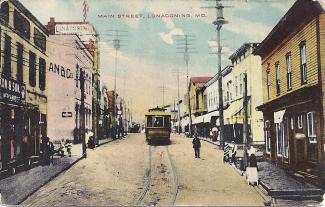Collection Name
About
The following article written by Lonaconing historian, Mary E. Meyers (1914-2008) was written in 1990. It was reprinted in the Cumberland Times-News, February 20, 2009 newspaper to help commemorate Black History Month.
Remembering the Blacks of Lonaconing
Mary E. Meyers
October, 1990
In "A History of Lonaconing Methodist Episcopal Church," written in 1904 by the pastor, Rev. Charles A. Jones, the author states that at that time there were about 35 Negroes living among the 7,000 residents of Lonaconing.
My mother, Catherine Douglas Meyers, who was born in Lonaconing in 1886, fondly remembered many of them. Among them were "Aunt" Sally Jacobs and her son, Will Jacobs. Mrs. Jacobs went on to Piedmont, W.Va., where she worked as a cook and housekeeper of a Mrs. Neff. Billy Brown lived on Church Hill and had been a coal miner before becoming employed as a gardener for the Sloan family and others.
Jeff Holly had a farm near McGowan's farm in the area that is now Dan's Mountain State Park. "Uncle" Jim Frazer drove a wagon for Hanley's store. Mariah Addison and Annie Addison lived in Hanley's Alley (now Ayers Alley) back of the Hanley's store (now Marshal's Confectionery.) A Negro man was the blacksmith for the mules in some of the coal mines. Christine "Teeny" Addison married Jim Frazer and they had a daughter, Louise. Teeny worked for Misses Nellie and Ann Sloan all her life. She was loved by everyone on Church Hill- especially the children who looked forward to a hug and treat from Teeny every Halloween.
That dear lady was the last Black person to live in Lonaconing. While she is buried in Oak Hill cemetery in Lonaconing, some Negroes are buried in unmarked graves in Old Coney cemetery.
Margaret Bell Sloan, 97 years young in 1990, said that Blacks came during the early days of Lonaconing and that some had been slaves. She said that Billy Brown was a "lovely man" and that she remembered Mary and Annie Addison because they worked as cooks and housekeepers for the Bell and Sloan families. Mary later moved on to Cumberland where she worked for Judge Sloan. She married a man named Hopewell Trent and worked for many years as a custodian at McCrory's store on Baltimore Street. She was held in such high esteem there that after her death the employees of the store kept flowers on her grave.
Mrs. Sloan said that the younger Black people sought employment elsewhere because they did not wish to be limited to work as domestics. Mrs. Sloan recalled that a young cousin of hers would frequently stray from home, but could always be found in Hanley's Alley where she went to sample good food at the Addison's house.
A building that served as a church and school for Negroes was located on Castle Hill. My aunt, Miss Lizzie Meyers, taught there in 1899. According to Ted Foote, there is no record of this school at the Allegany County Board of Education office. Aunt Lizzie was a teacher for many years at Central School in Lonaconing.
One thing I must note is that Mrs. Sloan, Aunt Lizzie, and my mother all spoke of the kindness, gentleness and good character of the Black people in Lonaconing.
Many of Mary Meyers' writings are now in the Special Collections Room at Frostburg State University and the George's Creek Regional Library in Lonaconing. This article was published in the newspaper with the permission of her brother, Michael Meyers.
The postcard of Lonaconing was postmarked in 1912. From the Collection of Albert and Angela Feldstein.
